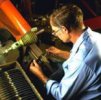dlk said:
Ted, Your explanation is clear. I meant I wanted to remove the (metal around the) scratches and then put the striations back, i.e., replicate the original finish. But for other applications the chemical idea sounds interesting. What chemical removes rust?
Dave
Dave,
Hydrochloric acid,diluted with an equal part of water,will remove rust quickly.
I'd start with 2 parts H2O(water) and one part HCl (hydrochloric).It will work
fast,so work carefully.
Naval Jelly (not from your bellybutton but,sold commercially) will also do it.
If you use a chemical,wear glasses,do it outside,and oil the blade after finishing as it will be very prone to rusting when cleaned with a chemical.
The Westinghouse plant that I worked in,used to manufacture turbine blades for jet engines using the lost-wax casting method.These were high-temperature alloys that were very hard,tough,and heat-resistant like Discaloy,Refractaloy,Stellite and certain grades of stainless.The smaller blades that were 5" long or less,were bead-blasted and then finished,using a 1" wide X 36" long Aluminum Oxide Wet/Dry grinding belts.The grit size went down to 600,but I don't recall the belt speed.The blade was hand-held and the operator developed their skills thru experience.
Silicon Carbide has a sharper grain than Aluminum Oxide and cuts better,when the belt is fresh.As the SiC breaks down,it will leave smaller particles that still have sharp edges.It will leave more prominent grind patterns,also.However,SiC is harder to bond to the belt and the less-sharp Aluminum Oxide will give better belt life.The Al2O3 belt life will probably be at least double that of SiC.
Since a knife blade is fairly flat,unless hollow ground,I would think the final finish would be easier with a belt,unless the wheel was a very large diameter.
"On what did I base my opinion ?,"- as Codger would say ?
I worked in the Spectrographic laboratory for many years during my early career.We performed the chemical analyses on many solid samples every day.These were prepared on a 6" X 60" (Wet) belt grinder.The finished samples had to be flat and have a uniform finish.Incoming condition ranged from wet-sawn to as-cast to ???.Some samples required a fairly large amount of stock removal. Sample prep was the mundane/dirty part of the job,but could impact the accuracy of the analyses,so I preferred to do my own sample prep rather than assigning an assistant to do it.
The job could be little hazardous too - if you were holding a 2" disk between thumb and index finger and putting some muscle into it to remove stock quickly,when the disk slips and your thumb pad and index finger go into the 60x or 120X belt,it gets thru the skin and down into the meat in a hurry. These "grinder burns" are as painful as a saw cut.
Ron




